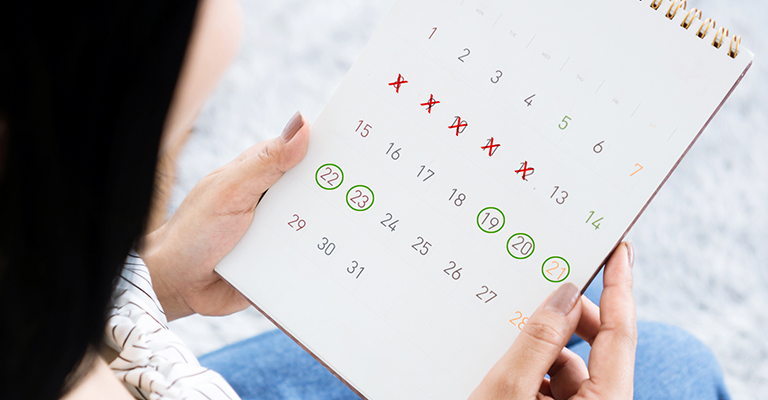Updated by the Progyny Clinical Team — August 2025.
When you’re trying to get pregnant, timing matters. Knowing when ovulation is likely to happen can help you plan and improve your chances of conception. Your body gives several signals that can help you figure out when ovulation is approaching.
Timing of ovulation
The timing of ovulation depends on the length of your menstrual cycle. For example, if you have a 28-day cycle, ovulation usually happens around day 14. If your cycle is longer or shorter, ovulation may occur on different days. The calendar method described below can help you estimate when ovulation may happen.
Signs of ovulation
Your body may give clues that you are ovulating. Common signs include:
Regular monthly periods
It’s typical for cycles to vary slightly month to month. But predictable monthly bleeding is the most reliable sign that you are ovulating. Menstrual bleeding happens when hormone levels drop after ovulation.
Cervical mucus changes
Before ovulation, cervical mucus may be dry or sticky. As ovulation approaches, it often becomes creamier. Just before ovulation, it may look clear, slippery, and stretchy. This happens when estrogen levels are high as an egg matures.
Basal body temperature (BBT)
Progesterone rises after ovulation and causes a small increase in body temperature. A sustained rise of about 0.4 degree Fahrenheit above your usual temperature often means ovulation has already occurred. You can track this using a BBT thermometer that measures to a tenth of a degree. This confirms ovulation but does not help with predicting it for timing pregnancy.
Other possible signs
Some people notice light spotting, mild abdominal pain, breast tenderness, bloating, or an increase in sexual desire. These can vary from cycle to cycle.
Ovulation predictor kits (OPKs)
OPKs are at-home tests that detect a surge in luteinizing hormone (LH). This surge usually happens 12 to 48 hours before ovulation, giving you advance notice to time intercourse or insemination.
OPKs may be less accurate if you have irregular cycles, polycystic ovary syndrome, or if you’re taking certain fertility medications. Some people may have high LH levels without ovulating, which can cause false positives. Others may have an LH surge that the test does not detect. If you’re getting positive OPKs for multiple days in a row or never get a positive result but have regular periods, talk with your doctor.
The best time for intercourse or insemination is the day you detect the LH surge and the day after.
The calendar method
If your cycles are regular, you can use a calendar to estimate ovulation. The second half of the menstrual cycle — the luteal phase — usually lasts about 14 days. That means ovulation typically happens 14 days before your next period.
- In a 28-day cycle, ovulation often occurs around day 14.
- In a 30-day cycle, ovulation is closer to day 16.
Cycle length may vary by a couple of days from month to month. When trying to conceive, it’s best to plan on the earlier side to avoid missing your fertile window.
Plan to have intercourse or insemination every one to two days during the five days before ovulation and on the day of ovulation itself.
When to see a specialist
It’s normal to have questions or feel uncertain when tracking ovulation. See a reproductive endocrinologist if:
- You are under 35 and have been trying for one year without success.
- You are 35 or older and have been trying for six months without success.
- Your cycles and ovulation windows are not predictable, or you have known medical conditions.
A fertility specialist can help identify possible causes and discuss treatment options.
Key takeaway
Everyone’s body is different. Noticing ovulation signs can help you better understand your cycle, but it’s also normal if the signs are subtle or inconsistent. If you’re unsure, your healthcare provider can guide you.
If you have questions or concerns, Progyny is here for you. Please contact your Progyny Care Advocate for support.
Disclaimer: The information provided by Progyny is for educational purposes only and is not medical advice. Always consult a qualified healthcare provider for medical guidance.
